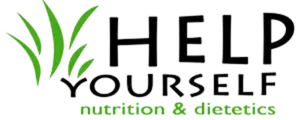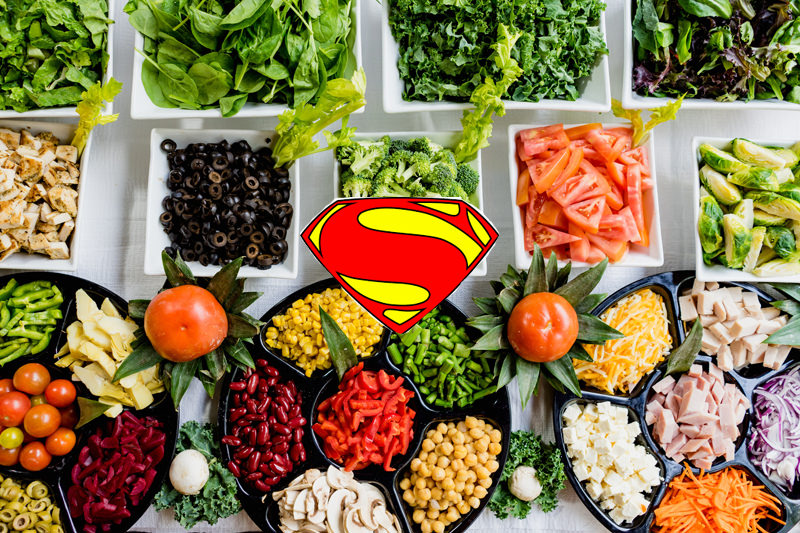Superfoods or Supernutrients
We often hear the term superfoods, but what are the things about these foods that make them so super? It is more likely the nutrients they contain – so in this article I am coining the term “supernutrients”.
A substance that provides nourishment for growth or metabolism in human beings is called a nutrient and if the body cannot produce a nutrient itself it is called an essential nutrient – meaning it is essential to obtain this nutrient from dietary sources. Carbohydrate, fats and protein are the “macro” or major nutrients, while vitamins, minerals and other vital but smaller food components are “micro” nutrients.
Nutrition is the process of nourishing our bodies using foods that contain these nutrients. The tricky thing about nutrition is that eating food is about so much more than simply obtaining the right balance of nutrients. It is easy to fall into the trap of labelling foods as the main nutrient they contain. We don’t eat “carbs” or “protein” or “fats”, we eat foods that might be higher in some of these nutrients and lower in others.
A diet that is dominated by foods that are high in helpful nutrients relative to their calorie value maximises our likelihood of staying as well as possible for as long as possible, so we can do as much of what we want to do in our lives as possible. In our current food environment it is a challenge to obtain all the nutrients we need from the amount of food energy (or calories) that we need.
A recent study of food composition estimated that to obtain all the necessary nutrients from an average western diet, a person would need to consume 30 000 calories (not kilojoules). That is how nutrient poor the average diet is. That means that an average daily food intake of about 3000 calories only contains 10% of the necessary nutrients – clearly a major problem and concern.
It is interesting but more than a little bit scary to consider the factors that are contributing to the reduced availability of these tiny but vital nutrients. The lower nutrient density of food has arisen from combination of lower nutrient content of soil in which fruit and vegetables are grown, shorter growing periods for animals intended for the food supply and more highly processed foods with additives that displace nutrients, changes to food production techniques, changes to cooking techniques and in some cases reduced absorption of nutrients into our bodies.
We are focusing on Iodine, folate, omega 3 oils, iron, Vitamin D and Vitamin B12 – some of the most vital micronutrients nutrients that have become limited either in our food supply or availability to our bodies. We will explore why they are less abundant in our food supply and how to ensure we are preventing deficiencies of essential nutrients.
Iodine
Iodine is an essential trace element necessary to make thyroid hormones. Thyroid hormones are required for normal growth and development of tissues and maturation of our bodies so obtaining iodine through the food supply is therefore paramount.
A classic example of where food production techniques and food consumption patterns has impacted on nutrient quality of foods is iodine. The introduction of new practices of sterilising equipment in the Australian dairy industry has reduced levels of iodine, so dairy has become a less reliable iodine source. Since the 1980’s there has also been a decline in the use and consumption of iodised salt due to health reasons and increased use of non-iodised sea salt. Iodine deficiency has re-emerged in this issue became so prominent that new laws were introduced, making it mandatory for bread manufacturers to use iodised salt in breadmaking.
Interesting iodine fact: The iodine content of plants and vegetables is dependent on the environment and soil in which they are grown.
Making the most of iodine: If you enjoy nori rolls or other combinations of seaweed and seafood, this combination is an ideal iodine booster.
Omega 3 oils
Omega-3 fatty acids are important for normal metabolism (check the impressive list of actions in the table). Omega-3 fatty acids (also called ω-3 fatty acids) are named by their structure, which contains more than one (poly) double bonded carbon and the first point where it is “unsaturated” (by hydrogen) is at the third carbon atom from the end of the carbon chain.
The three types of omega-3 fatty acids involved in human physiology are α-linolenic acid (ALA) (from plant oils), eicosapentaenoic acid (EPA) and docosahexaenoic acid (DHA) (both commonly found in marine oils). Humans cannot produce omega-3 fatty acids, but can obtain the shorter-chain omega-3 fatty acids like ALA through diet and use it to form the more important long-chain omega-3 fatty acids, EPA and then turn EPA into the most crucial, DHA. This conversion process can be impaired with aging and if the diet is high in omega-6 oils.
Interesting omega 3 facts: In foods exposed to air, unsaturated fatty acids are vulnerable to oxidation and rancidity. This is the reason why linseed oil is used to season cricket bats – as soon as the linseed oil is exposed to the oxygen in air, it goes rancid which makes it go hard, which is great for cricket bats, but not healthy for human beings.
Making the most of omega 3: Try to obtain the majority of your omega 3 from marine foods if possible – check the DHA content on food labels – aiming for 100mg per serve.
Folate
Especially important for women, folate (and folic acid, the less fragile version found in fortified foods and supplements) is best known for its vital role in cell development. The importance of folate in preventing birth defects means that women of child-bearing age are advised to supplement dietary folate. The emerging role of folate in reducing risk of chronic diseases such as heart disease relates to its role in cell division. Folate is considered to be of such importance that the majority of breakfast cereals and commercial breads are fortified with this mineral.
Interesting folate fact: Folate is also called Vitamin B9 and its name is derived from the Latin word folium, which means “leaf”. Folate deficiency develops over time as we can store 500–20,000µg in our bodies.
Making the most of folate: Steam, microwave or eat dark green leafy vegetables raw to preserve the folate.
Iron
Iron is found in every human cell and affects everything from our immune system, brain development and temperature, to our metabolism and work performance. Iron is probably the best known but most misunderstood of our “supernutrients”. Most of us know that iron is imperative for our energy levels due to its ability to transport and store oxygen.
Low iron levels are common amongst women due to loss of blood during our menstrual cycle, but that doesn’t stop us from blaming other factors such as lack of sleep, too much work and stress for our fatigue. Less well known is iron’s vital role in immune function, so those with low iron (anaemia) are also susceptible to infection.
There are two types of iron that we can get from foods. Iron from animal sources is known as haem iron and iron from plant-based sources is called as non-haem iron. Haem means blood, so haem iron comes from the blood of animals, with beef, game meats and lamb being the best sources.
Haem iron is probably absorbed about four times as well as non-haem iron, making it more challenging (but possible) for non-meat eaters to obtain enough iron. Some foods help our bodies absorb iron, while others can inhibit it. Lightly cooking plant foods improves iron absorption into the blood, while tea, coffee, some medications or excess fibre decrease iron availability.
Interesting Iron fact: Using old fashioned cast iron cookware to increase iron content of foods so get out those garage sales and find yourself some cast iron pots and pans.
Haemachromatosis is not caused by too much dietary iron, but for those who have excess iron in the blood it is important to avoid eating too much iron rich food.
Making the most of iron: Eat vitamin C rich foods with non-haem iron foods and avoid drinking tea or coffee at the same time.
Vitamin B12
Vitamin B12 is necessary to form the DNA in our genes, make healthy blood cells and keep nerves working properly. Low levels of vitamin B12 can cause a type of anaemia called pernicious anaemia. Vegetarians who eat no animal products and the elderly who absorb less vitamin B12 are most at risk. Vitamin B12 is found only in animal foods and fortified foods. People who avoid all animal products should look for meat alternatives, such as soy products fortified with vitamin B12.
Interesting B12 fact: Mushrooms and yeast are not reliable sources of Vitamin B12. The only reliable vegetarian sources include fortified foods such as soy milk and tofu.
Making the most of B12: Vitamin B12 absorption decreases as we get older. It is advisable for adults over 50 years to consume foods fortified with vitamin B12 or a supplement containing vitamin B12.
Vitamin D
Vitamin D was assumed to be abundant in sunny Australia, but is becoming an increasingly diagnosed deficiency state, and deficiency doesn’t just affect the bones. The body itself manufactures vitamin D in the skin upon exposure to sunlight, but not if the skin is protected by sunscreen. Vigilant use of sunscreen blocks UVB rays, the type our bodies use to make Vitamin D. Skin also has a harder time producing vitamin D with age.
All this adds up to a major public health concern, as evidence mounts that vitamin D, long associated with bone health, also helps to regulate the immune system, lower blood pressure, protect against depression, and reduce risk of type 2 diabetes, high blood pressure, and several kinds of cancer.
Interesting Vitamin D fact: Free range eggs have up to 4 times the vitamin D of supermarket eggs.
Making the most of Vitamin D: Eat foods high in Vitamin D if possible because it is mainly in the more useful Vitamin D3 form. If taking a supplement, check that it contains Vitamin D3 rather than Vitamin D2.
Some early morning and evening sun exposure on the forearms and legs without sunscreen is recommended to optimise Vitamin D. Your hands, face and arms (or equivalent area of skin) need to be exposed to sunlight for about five to 15 minutes four to six times a week in summer. People over 50 years of age people with darker skin need more exposure to the sun – about 15 minutes, five to six times a week in summer.
Summary and tips
You can see from this information that if you don’t eat any fortified foods or are vegetarian, then it is more challenging to obtain enough dietary “supernutrients”, not impossible but challenging. For those nutrients where you know you have had deficiencies or are concerned that you may be deficient, I suggest getting a blood test first so you know for sure and have a benchmark level to compare with into the future.
Each and every one of us has our own unique dietary needs and priorities when it comes to ensuring health and preventing illness of chronic disease. Our genetic blueprint impacts on our susceptibility to different health issues, our food preferences and lifestyle determine how this genetic susceptibility plays out through life. Knowing which nutrients are the most limited in our food supply and most necessary for our health is the first step towards eating for a long and healthful life.
Our dietitians can help you identify the most appropriate nutrients for you.

